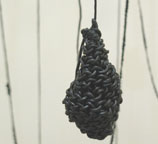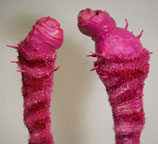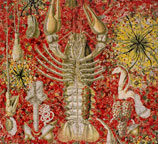
| May 2009: | ||||||||||||||
|
Pretty:Disturbing
May 1-30, 2009 Opening Reception: May 2nd, 6–10pm • click for images Closing Reception: May 29th, 6–9pm Pamela Grau Twena , Nancy Harlan, YaYa Chou & Miriam Wosk Nancy Harlan, Pamela Grau Twena Miriam Wosk and Yaya Chou are women who are making art with refuse materials from our consumer-based society. Turning waste and remnants into art is not new but these four unique artists have put a contemporary spin on the medium, creating objects that are mystifying, seductive and beautiful. The show explores issues that are personal and political, enticing and disturbing, mundane and profound using materials that are deemed ordinary. We encourage you not to miss this exceptional exhibition at Orange County Center for Contemporary Art.
Pamela Grau Twena, Nancy Harlan, Miriam Wosk, YaYa Chou
Pamela Grau Twena Next, in a spirit of nature gone gaga, I have put together round astro-turf islands that hold mutated flora/fauna forms made with the (for now) indispensable socks and assorted found objects. The groupings symbolize human relationships in all their complexity. It’s a reversal of natural order they play roles assigned to humanity. I have dubbed these flower-bodied proto-humans “Mutablossoms.”
Nancy Harlan We also have an interior history made up of our internal life. This history holds our fears self doubt, rage, self reproach, strengths, joy and compassion. It reveals the voices in the head that tell us we are not good enough, not smart enough, not talented enough, and just not enough. It holds our faith in something greater than ourselves that gets us through the day, whether it is materialism or spirituality. It is my internal voice that I am developing and revealing. I have been delighted by found objects for a long time, looking for small treasures in the gutters while I walk. Lately, I have become fascinated with packaging, with the containers designed to hold consumable products. We toss this stuff aside like children awash in wrapping paper at Christmas. And yet, it captured my attention. I began to notice that, at times, the packaging was significantly more interesting than the item it enclosed. And when you place multiple pieces in a design it creates its own beauty. “Tapestry” is more than a thousand plastic holders for coke and beer cans which hold all the joys, sorrows, frustrations and life events of my past year carefully recorded each day with colored Sharpie pens. Tapestry speaks of our carefully guarded secrets exposed en masse. The “Cost of Convenience,” a series of dyed plastic bags on wooden hangers is about the fragility of life. Two of the works in the show are installation works in collaboration with other artists. Pamela Grau Twena and I are installing thousands of hand dyed plastic grocery bags for “Pacific Vortex” to create an ocean of color with swirling glowing debris. YaYa Chou and I are installing a worship center made of styrofoam that provokes questions about what we revere.
YaYa Chou “Realized opinion” is the first piece of my new series, “Compromised Interpretation.” I create large scale installation using my mother’s discarded calligraphy studies. On a personal level, these studies represent my mother’s emotions and dilemma as a modern woman in a traditional family. They are the language she uses to express herself and construct her reality, which I recycle to build a virtual world. I am interested in reinterpreting her belief about marriages and investigate the distance between truth and belief
Miriam Wosk Beside the beauty of life lurks a shadow. In the shadow, the dark. Beauty becomes a modus operandi as a way of metaphorically staving off death, and making everything in life as bountiful and alluring as possible. To make things gorgeous is to give solace, and nurture a troubled or fearful spirit. If all's not right in life, I can escape into the illusions created in a exquisite and flawless world of my own making. However the contradiction exists between the idealized version of my intention, and the imperfection of being human. In the space created by the inability to express myself in this optimal way, lies the true reflection of who I am. Through the frustrations of art making, in giving up my delusions of perfection, and accepting my own imperfect humanity with all its eccentricities and idiosyncrasies lies my authentic self. From this struggle as an artist comes forth the realm of unconscious contradictions. Art made from this deep personal place does not lie, just as one's dreams do not lie. It emanates from that unknown place in myself, if only I can get out of my own way, and stop trying to control that voice. There is often a battle of wills going on between the intellect and the instinct. Which part of oneself can you trust, how can you find the right balance? The artistic process mirrors the struggle of those voices as I try to express all that I am. All art is autobiographical as it reflects the time and place and person who made it, so as a visual journal of a life it is most meaningful. As a means of growth and healing it has proved invaluable.
|
||||||||||||||
| timeline: | ||||||||||||||
| 2029 | 2028 | 2027 | 2026 | 2025 | 2024 | 2023 | 2022 | 2021 | 2020 | |||||
| 2019 | 2018 | 2017 | 2016 | 2015 | 2014 | 2013 | 2012 | 2011 | 2010 | |||||
| 2009 | 2008 | 2007 | 2006 | 2005 | 2004 | 2003 | 2002 | 2001 | 2000 | |||||
| 1999 | 1998 | 1997 | 1996 | 1995 | 1994 | 1993 | 1992 | 1991 | 1990 | |||||
| 1989 | 1988 | 1987 | 1986 | 1985 | 1984 | 1983 | 1982 | 1981 | 1980 | |||||
|
||||||||||||||
| orange county center for contemporary art • all images & content copyright © 2021 | ||||||||||||||


